INSTRUCTIONS TO CANDIDATES
- Write your name and Index Number in the space provided above.
- Sign and write the date of examination in the spaces provided.
- This paper consist of TWO section; A and B.
- Answer ALL questions in Section A and B in the spaces provided.
- ALL working MUST be clearly shown.
- Mathematical tables and electronic calculators may be used.
FOR EXAMINERS USE ONLY
|
SECTION |
QUESTION |
MAXIMUM SCORE |
CANDIDATES SCORE |
|
A |
1-12 |
25 |
|
|
B |
13 |
9 |
|
|
14 |
11 |
|
|
|
15 |
13 |
|
|
|
16 |
09 |
|
|
|
17 |
13 |
|
|
|
TOTAL |
80 |
|
|

QUESTION
SECTION A (25 MARKS)
- A micrometer screw gauge has a zero error of -0.03mm. It is used to measure the diameter of a wire. If the actual diameter of the wire is 0.30mm, draw the micrometer screw gauge showing the measured diameter of the wire. (3mks)
- The height of the mercury column in a barometer at a place is 64cm. What would be the height of a column of paraffin in barometer at the same place? (Density of paraffin = 8.0 x 102 kgm-3) (3mks)
- Figure 1 shows two aluminium container A and B placed on a wooden table containers A and B have equal volume of hot water initially at the same temperature
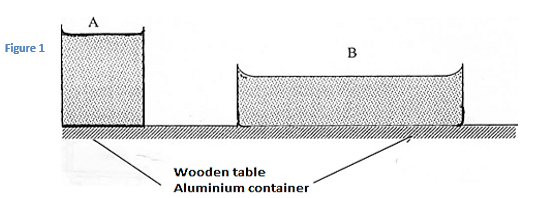
Explain why water in B cools faster than water in A. (1mk) - Smoke particles in air when strongly illuminated were observed to describe a continuous random and haphazard motion. Explain what would be observed if air temperature is decreased (2mks)
- Two 10g masses were fixed using wax on the sides of two aluminium plates of same thickness. One of the plates was polished shinny while the other was painted black. The heater was placed close to the shiny plate but further away from the blackened plate. Explain why the two masses fell off at the same times (2mks)
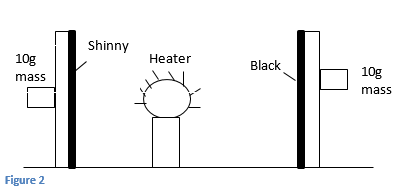
- Explain why gases easily compressible while liquids and solids are almost incompressible (2mks)
- State two properties of a clinical thermometer that make it suitable for measuring body temperature (2mks)
- The pointer of a spring points at 2 cm when no load has been added. A mass of 200g is added and the pointer points at 6cm. Determine the load that makes the pointer indicate 9.5cm ( 3mks)
- Sketch a velocity – time graph to show motion of a body thrown vertically upwards with an initial velocity of u m/s up to the maximum height ( 1mk)
- A uniform rod of length 4m and mass 4 kg is pivoted at 3.6m mark. The rod is held horizontally with a vertical rope at 4m mark as shown below
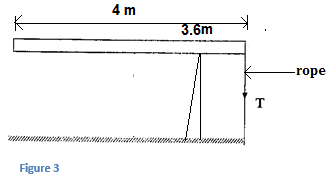
Calculate tension T in the rope (Take g=10N/kg) (3mks) - One of the transport TLB rules is that a passenger should put on the safety belt. Explain how the belt enhances safety in case of an accident. (1mk)
- The figure below shows a vessel resting on a horizontal bench.
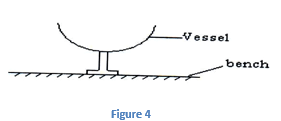
State and explain the effect on the stability of the vessel when it is filled with water. (2mks)
SECTION B : ( 55 marks)
(Answer all the questions in this section)
-
- 1200g of liquid at 10°C is poured into a well-lagged calorimeter. An electric heater rated 1KW is used to heat the liquid. The graph below shows the variation of the temperature of the liquid with time.

- State the boiling point of the liquid in Kelvin scale. (1mk)
- State a reason why the graph does not start from origin. (1mk)
- Determine how much heat is given out by the heater to heat the liquid to the boiling point. (2mks)
- Determine the specific heat capacity of the liquid (2mks)
- If 50 g of the liquid vapor was collected by the end of the 8th minute, determine the specific latent heat of vaporization of the liquid. (3mks)
- 1200g of liquid at 10°C is poured into a well-lagged calorimeter. An electric heater rated 1KW is used to heat the liquid. The graph below shows the variation of the temperature of the liquid with time.
-
- State the pressure law for an ideal gas. (1mk)
- The pressure P of a fixed mass of a gas at a constant temperature of T=200K is varied continuously and values of corresponding volume recorded. A graph P against 1/v is shown on grid below.
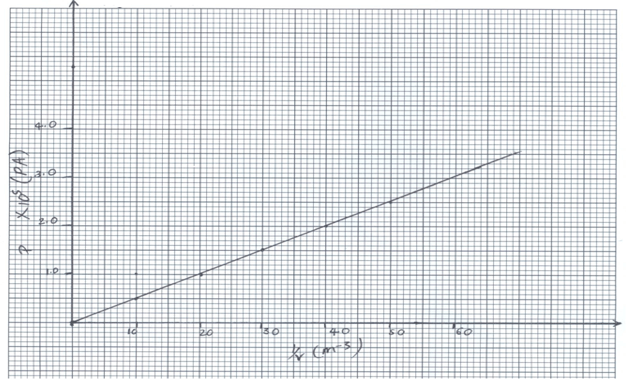
Use the graph to determine:- The volume of the gas when the pressure reads 2.8 × 105 pa (2mks)
- The Slope of the graph. (2mks)
- Given that T= PV/2R where R is a constant, use the slope obtained in (ii) above to determine the Value of R (3mks)
- The petrol air mixture in the cylinder of a car engine is ignited when the piston is in the position shown below.
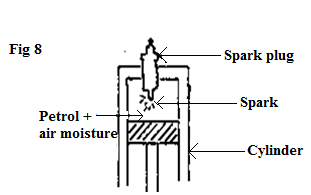
Explain in terms of kinetic theory why the piston moves downwards. (3mks)
-
- State the law of floatation. (1mk)
- A block of wood of mass 80kg floats in water with 0.6 of its volume in water. Calculate the number of rods each 20g that can be placed on the block so that its top is level with the surface of water. (4mks)
- The diagram in figure 9 below shows a wooden block of dimensions 50cm by 40cm by 20cm held in position by a string attached to the bottom of a swimming pool. The density of the block is 600kgm-3.
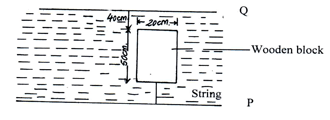
- State the three forces acting on the block and write an equation linking them when the block is stationary. (2mks)
- Calculate the tension on the string. (3mks)
- The figure below shows a metal rod AB of length 2m horizontally balanced while supported by a pivot and a string.
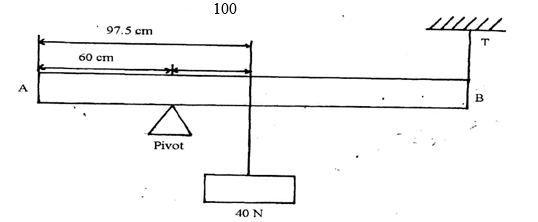
Determine the mass of the metal rod if the tension is 15N. (3mks)
-
- The figure below shows asses A, B and C placed at different points on a rotating table.
The angular velocity W, of the table can be varied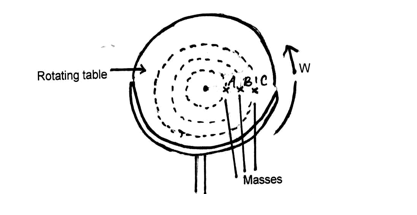
- State and Explain two factors that determine whether a particular mass slides off the table or not. (4mks)
- It is found that the masses slide off at angular velocities WA, WB and WC respectively. Arrange the values of WA, WB and WC in decreasing order. (1mk)
- A block of mass 200g is placed on a frictionless rotating table while fixed to the centre of the table by a thin thread. The distance from the Centre of the table to the block is 15cm. If the maximum tension the thread can withstand is 5.6N, determine the maximum angular velocity the table can attain before the thread cuts. (4mks)
- The figure below shows asses A, B and C placed at different points on a rotating table.
- A stone thrown vertically upwards from the base of a mountain with an initial velocity of 100m/s. The stone just stopped as the apex and came back. Another boy projected a stone horizontally from the top of the mountain. Calculate:-
- Height of the mountain. (3mks)
- Time taken for the stone to follow the trajectory. (2mks)
- The range if the horizontal velocity is 20m/s, (2mks)
- Calculate the impulse of force produced when a table is pulled for 3s by a constant force of 10N towards the right and then for 2s by a constant force of 20N towards the left. (2mks)
- The figure below shows a tape from a trolley accelerating at 5m/s2 and the timer is vibrating at 100Hz.

Calculate:- Change in velocity from A to B. (2mks)
- The final velocity of the trolley. (2mks)

MARKING SCHEME
- Measured diameter = 0.30
0.03
-
- 12000/4=3000N √ 1
- P=F/A√
3000 ×10000 = 375,000pa √
80
- It has a larger surface area exposed for liquid to escape/evaporate escaping with latent heat from the liquid.
- The K.E of the smoke particles reduce and hence their movements will be slower (reduces)
- Dull black surface is a good absorber of radiant heat while shinny is a good reflector ( 1 mk)
The heating is same since shinny has been moved closer - Gases have larger intermolecular distances√1
- - Constriction√
- Narrow bore√
- High temperature range√ - F =Ke ( 1 mk)
2 = K x 0.04
K = 50N/m ( 1 mk)
F = 50 x 0.075
= 3.75N ( 1 mk) -

- Sum of clockwise movement= Sum of anticlockwise movement
or
- As the vehicle brakes it stretches increasing time for impact hence reducing the impulse.√
- Lowered
As the water fills the vessel the centre of gravity rises and this lowers stability. -
-
- √ - working must be shown.
- Room temperature√
- Q=Pt√
=1 × 1000w × 5 × 60
or
= 300000J√ - MCΔθ = Pt
1200kg × C × 70K = 300000J
1000
C = 300000J
84KgK
= 3571.4J/Kg/K - M1 = Pt
50kg × Lv = 1000 × 3 × 60J
1000
Lv = 3.6 × 106 J/Kg
-
-
- The pressure of a fixed mass of an ideal gas is directly proportional to the absolute temperature provided the volume remains constant.√
-
- 1/v = 55
v = 1/55 = 0.01812cm3 - Slope of the graph
Slope = (2.0 - 0) × 105 N/M2 = 5 × 103 NM
(40 - 0 ) × 100 / M3 - T = PV
2R
P = 2RT
V
5 × 103 = 2 × R × 200
R = 12.5J/K
Graph P against 1/v therefore slope = 2RT
T = 200K
Allow TE
- 1/v = 55
- Increase in temperature causes molecules to move faster (gain kinetic-energy √causing more number of collisions with the walls√ of cylinder at constant pressure volume increase as the molecules push √against the wall.
-
- Floating object displaces its own weight of the fluid in which it floats.
- Mass of water displaced by wood = 80kg
Volume of water displaced = 80 = 0.08m3
1000
but 0.08m3 = 0.6 of the volume of block.
→ Volume of wood = 0.08 = 0.1333m3;
0.6
Volume displaced by rods = 0.08 – 0.1333 = 0.0533
Mass of he rods = 0.053 x 1000 = 53.3kg;
Mass of one rod = 20g = 0.02kg
Number of rods = 53.3;
0.02
= 2,665 rods; -
- Up thrust force
Weight Max. 2 or 3;;
Tension on the string 1
Up thrust = weight + tension on the string; - Up thrust = weight + tension
(50 x 40 x 20) 1000 x 10 = 50 x 40 x 20 x 6000 + tension;;
1000000 100000
Tension = 200 – 240
= -40N
- Up thrust force
- Sum of clockwise Moments = Anti clockwise Moments
- 37.5 x 40 + W x 40 = 140 x 15
1500 + 40W = 2100
40W = 2100 – 1500
40W = 600
W = 6N
W = 15N
M = 1.5Kg or 1500g
- 37.5 x 40 + W x 40 = 140 x 15
-
-
- Roughness / smoothness of surface / radius of path / angular velocity/ speed. (any two)
- WA > WB > WC
-
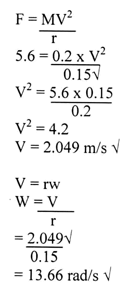
-
-
- Vertical projection U = 100m/s g = -10m/s v = om/s
V2 = u2 – 2gs
O2= (100)2 – 2 x 10 x 5
20s = 10,000
s = 500m - Horizontal projection h = ½ gt2
500 = ½ x 10 x t2
t2 = 100
t = 10s - Range R = ut
R = 20 x 10
= 200m - Impulse = change in momentum
Ft = (10N x 35) – (20N x 25)
= -10NS -
- v – u = a
t
t = (5 ticks x 0.01)s
= 0.05s
Therefore Δv = 5cm/s2
0.05
Δv = 0.25cm/s - v – u = 0.25cm/s
u = 0.125cm
0.01
= 12.5cm/s
V – 12.5 = 0.25
V = 12.75cm/s
- v – u = a
- Vertical projection U = 100m/s g = -10m/s v = om/s
Download Physics P1 Questions and Answers - Nambale Mock Exams 2021/2022.
Tap Here to Download for 50/-
Get on WhatsApp for 50/-
Why download?
- ✔ To read offline at any time.
- ✔ To Print at your convenience
- ✔ Share Easily with Friends / Students

